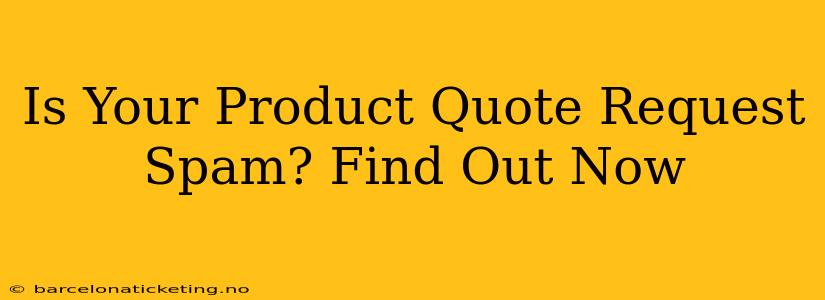In today's digital landscape, navigating the line between legitimate business inquiries and spam can be tricky. Product quote requests, while essential for sales, often fall into a gray area. This comprehensive guide helps you identify whether a quote request is genuine or a potential threat to your business. We'll explore various red flags, provide practical tips for verification, and ultimately empower you to confidently handle these requests.
What Makes a Product Quote Request Suspicious?
Several indicators suggest a quote request might be spam or a phishing attempt. Let's examine these red flags:
-
Generic or Incomplete Information: A request lacking specific details about the product, quantity, or intended use is a major warning sign. Legitimate businesses invest time in detailing their needs. Vague inquiries often mask malicious intent.
-
Unusual Email Addresses or Domains: Be wary of requests originating from free email services (like Gmail or Yahoo) or domains that seem unrelated to the business's stated purpose. Look for misspellings in the email address or domain name, as these are common in phishing attempts.
-
Suspicious Attachments: Never open attachments from unknown senders, especially if they're unexpected. These attachments could contain malware that infects your computer system. Always verify the sender's identity before interacting with any attachments.
-
Urgent or Pressured Tone: Requests demanding immediate responses or applying undue pressure are often a tactic to bypass your security protocols. Legitimate businesses usually understand the need for thorough due diligence.
-
Unrealistic Orders: Excessively large orders or requests for unusually low prices can be a sign of fraudulent activity. These orders may be attempts to launder money or obtain products for illicit purposes.
How Can I Verify a Product Quote Request?
Verifying a quote request's legitimacy requires a proactive approach:
-
Check the Sender's Website: Investigate the company's online presence. A legitimate business will have a well-established website with contact information, an "About Us" section, and client testimonials.
-
Reverse Phone Lookup: If the request includes a phone number, use a reverse phone lookup service to verify the number's authenticity and associated business.
-
Social Media Verification: Search for the company's presence on social media platforms like LinkedIn, Facebook, or Twitter. This can offer additional insights into their legitimacy and business practices.
-
Ask for Clarification: If anything seems unclear or suspicious, politely request additional information. A legitimate business will gladly provide further details to address your concerns. Don't hesitate to ask clarifying questions about their specific needs and project details.
Is it Spam if the Request Comes Through a Contact Form?
While contact forms offer a layer of protection, they're not foolproof. Spammers can still exploit vulnerabilities or use automated tools to submit requests. Even requests coming through contact forms should be scrutinized for the red flags mentioned earlier. Pay attention to the level of detail provided and the overall tone of the message.
How Can I Prevent Future Spam Quote Requests?
Proactive measures can significantly reduce spam:
-
Implement Strong Email Filters: Utilize robust email filtering and spam protection tools to identify and block suspicious emails.
-
Regularly Review Your Contact Form: Monitor submissions closely and look for patterns of spam or suspicious activity.
-
Use CAPTCHA: Integrate CAPTCHA or similar security measures into your contact form to deter automated submissions.
-
Educate Your Team: Train your sales and marketing teams to identify and handle suspicious requests.
By carefully evaluating quote requests and employing these verification methods, you can protect your business from spam, phishing, and other potential threats. Remember, it's always better to err on the side of caution when dealing with unfamiliar inquiries. Your vigilance is your best defense.

